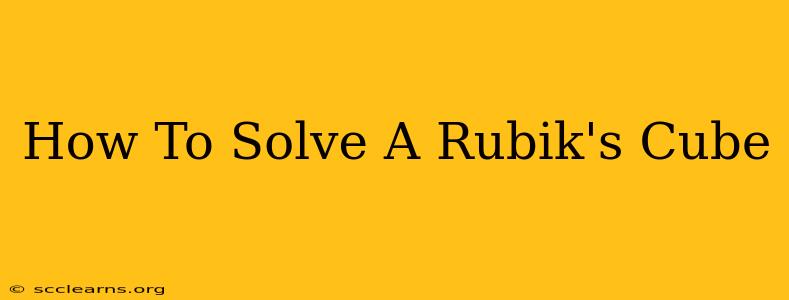The Rubik's Cube: a seemingly impossible puzzle that has captivated minds for decades. But don't worry, solving it isn't as daunting as it looks! This guide will break down the process into manageable steps, guiding you from complete beginner to cube-conquering master. We'll cover the essential algorithms and techniques, making this challenging puzzle surprisingly accessible.
Understanding the Rubik's Cube
Before diving into the solutions, it's crucial to understand the cube's structure. The Rubik's Cube is composed of six faces (usually red, blue, green, orange, yellow, and white), each with nine color squares. Each face can rotate independently, creating millions of possible combinations. Our goal is to systematically rearrange these squares until each face displays a single color.
Cube Notation: The Language of Solving
To effectively communicate solving methods, we'll use a standard notation. Each face is represented by a letter:
- F (Front): The face you're looking at.
- B (Back): The face opposite the front.
- R (Right): The face to your right.
- L (Left): The face to your left.
- U (Up): The face on top.
- D (Down): The face on the bottom.
A letter by itself (e.g., R) means to turn that face 90 degrees clockwise. Adding an apostrophe (e.g., R') indicates a 90-degree counter-clockwise turn. A "2" (e.g., R2) means to turn the face 180 degrees.
The Beginner's Method: Step-by-Step
This method breaks the solution into layers. We'll build the cube one layer at a time, starting with the white cross.
Step 1: The White Cross
The first step involves creating a white cross on the top (usually white) face. This involves manipulating the edge pieces to form a plus sign with the white center in the middle. There's no single algorithm for this; it requires intuition and careful observation. Focus on bringing white edge pieces to their correct positions.
Step 2: Completing the White Layer
Once the white cross is complete, we need to position the corner pieces to finish the entire top layer (white layer). Algorithms become more helpful here. Several algorithms can help position these corner pieces correctly. Searching online for "beginner Rubik's Cube algorithms white corners" will provide various options.
Step 3: The Middle Layer
Next, we move to the middle layer. This involves bringing the four edge pieces from the middle layer to their correct positions without disturbing the solved top layer. Again, specific algorithms are key for this stage. Look up algorithms for solving the middle layer of a Rubik's Cube.
Step 4: The Yellow Cross
Now, we focus on the yellow face. The goal here is to create a yellow cross on the top face. There are algorithms designed specifically to orient the yellow edges correctly. These algorithms help to solve the yellow cross quickly and efficiently.
Step 5: Orient the Yellow Corners
With the yellow cross complete, the next step is to orient the yellow corner pieces, making sure all yellow pieces are on the top face.
Step 6: Permute the Yellow Corners
Finally, we'll position the yellow corners correctly, completing the cube. Algorithms for permuting yellow corners are widely available online. Remember to practice each step until you're comfortable before moving to the next.
Practice Makes Perfect
Solving a Rubik's Cube takes time and practice. Don't get discouraged if you don't solve it immediately. Consistent practice, coupled with learning the algorithms, is the key to success. There are many online resources, videos, and tutorials that can help you visualize and master these steps. Good luck and happy cubing!

